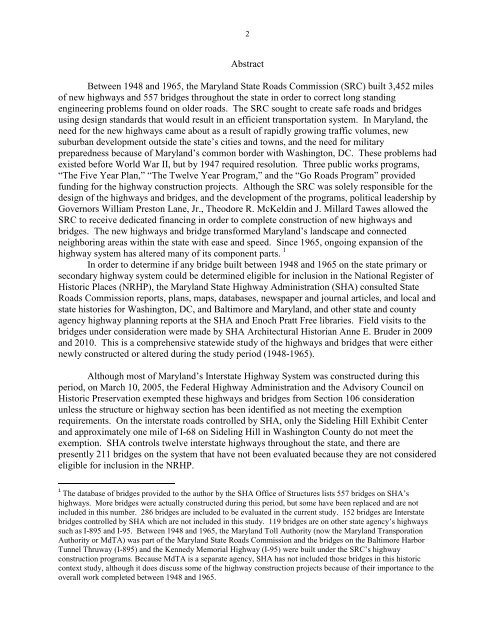TOMORROW'S ROADS TODAY - Maryland State Highway ...
TOMORROW'S ROADS TODAY - Maryland State Highway ...
TOMORROW'S ROADS TODAY - Maryland State Highway ...
You also want an ePaper? Increase the reach of your titles
YUMPU automatically turns print PDFs into web optimized ePapers that Google loves.
2<br />
Abstract<br />
Between 1948 and 1965, the <strong>Maryland</strong> <strong>State</strong> Roads Commission (SRC) built 3,452 miles<br />
of new highways and 557 bridges throughout the state in order to correct long standing<br />
engineering problems found on older roads. The SRC sought to create safe roads and bridges<br />
using design standards that would result in an efficient transportation system. In <strong>Maryland</strong>, the<br />
need for the new highways came about as a result of rapidly growing traffic volumes, new<br />
suburban development outside the state’s cities and towns, and the need for military<br />
preparedness because of <strong>Maryland</strong>’s common border with Washington, DC. These problems had<br />
existed before World War II, but by 1947 required resolution. Three public works programs,<br />
“The Five Year Plan,” “The Twelve Year Program,” and the “Go Roads Program” provided<br />
funding for the highway construction projects. Although the SRC was solely responsible for the<br />
design of the highways and bridges, and the development of the programs, political leadership by<br />
Governors William Preston Lane, Jr., Theodore R. McKeldin and J. Millard Tawes allowed the<br />
SRC to receive dedicated financing in order to complete construction of new highways and<br />
bridges. The new highways and bridge transformed <strong>Maryland</strong>’s landscape and connected<br />
neighboring areas within the state with ease and speed. Since 1965, ongoing expansion of the<br />
highway system has altered many of its component parts. 1<br />
In order to determine if any bridge built between 1948 and 1965 on the state primary or<br />
secondary highway system could be determined eligible for inclusion in the National Register of<br />
Historic Places (NRHP), the <strong>Maryland</strong> <strong>State</strong> <strong>Highway</strong> Administration (SHA) consulted <strong>State</strong><br />
Roads Commission reports, plans, maps, databases, newspaper and journal articles, and local and<br />
state histories for Washington, DC, and Baltimore and <strong>Maryland</strong>, and other state and county<br />
agency highway planning reports at the SHA and Enoch Pratt Free libraries. Field visits to the<br />
bridges under consideration were made by SHA Architectural Historian Anne E. Bruder in 2009<br />
and 2010. This is a comprehensive statewide study of the highways and bridges that were either<br />
newly constructed or altered during the study period (1948-1965).<br />
Although most of <strong>Maryland</strong>’s Interstate <strong>Highway</strong> System was constructed during this<br />
period, on March 10, 2005, the Federal <strong>Highway</strong> Administration and the Advisory Council on<br />
Historic Preservation exempted these highways and bridges from Section 106 consideration<br />
unless the structure or highway section has been identified as not meeting the exemption<br />
requirements. On the interstate roads controlled by SHA, only the Sideling Hill Exhibit Center<br />
and approximately one mile of I-68 on Sideling Hill in Washington County do not meet the<br />
exemption. SHA controls twelve interstate highways throughout the state, and there are<br />
presently 211 bridges on the system that have not been evaluated because they are not considered<br />
eligible for inclusion in the NRHP.<br />
1 The database of bridges provided to the author by the SHA Office of Structures lists 557 bridges on SHA’s<br />
highways. More bridges were actually constructed during this period, but some have been replaced and are not<br />
included in this number. 286 bridges are included to be evaluated in the current study. 152 bridges are Interstate<br />
bridges controlled by SHA which are not included in this study. 119 bridges are on other state agency’s highways<br />
such as I-895 and I-95. Between 1948 and 1965, the <strong>Maryland</strong> Toll Authority (now the <strong>Maryland</strong> Transporation<br />
Authority or MdTA) was part of the <strong>Maryland</strong> <strong>State</strong> Roads Commission and the bridges on the Baltimore Harbor<br />
Tunnel Thruway (I-895) and the Kennedy Memorial <strong>Highway</strong> (I-95) were built under the SRC’s highway<br />
construction programs. Because MdTA is a separate agency, SHA has not included those bridges in this historic<br />
context study, although it does discuss some of the highway construction projects because of their importance to the<br />
overall work completed between 1948 and 1965.
















